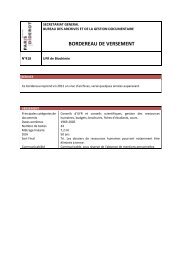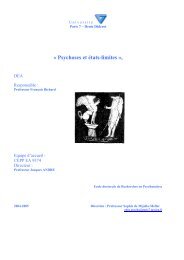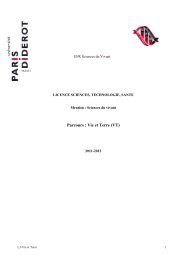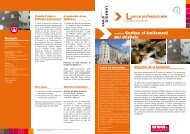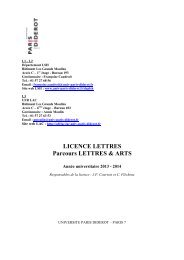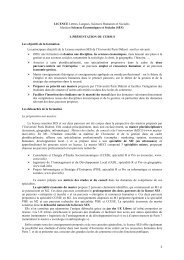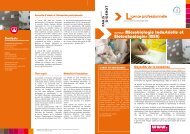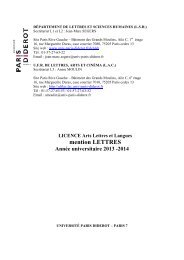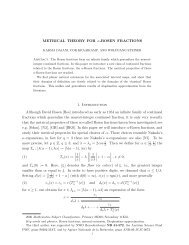THE ARITHMETIC OF PARTITIONS INTO DISTINCT PARTS 1 ... - liafa
THE ARITHMETIC OF PARTITIONS INTO DISTINCT PARTS 1 ... - liafa
THE ARITHMETIC OF PARTITIONS INTO DISTINCT PARTS 1 ... - liafa
You also want an ePaper? Increase the reach of your titles
YUMPU automatically turns print PDFs into web optimized ePapers that Google loves.
<strong>THE</strong> <strong>ARITHMETIC</strong> <strong>OF</strong> <strong>PARTITIONS</strong> <strong>INTO</strong> <strong>DISTINCT</strong> <strong>PARTS</strong><br />
SCOTT AHLGREN AND JEREMY LOVEJOY<br />
1. Introduction.<br />
A partition of the positive integer n into distinct parts is a decreasing sequence of positive<br />
integers whose sum is n, and the number of such partitions is denoted by Q(n). If we adopt the<br />
convention that Q(0) = 1, then we have the generating function<br />
∞∑<br />
∞∏<br />
Q(n)q n = (1 + q n ) = 1 + q + q 2 + 2q 3 + 2q 4 + 3q 5 + ...<br />
n=0<br />
n=1<br />
From Euler’s Pentagonal Number Theorem we know that almost all values of Q(n) are even.<br />
More precisely,<br />
∞∑<br />
∞∑<br />
Q(n)q n ≡ q n(3n+1)/2 (mod 2),<br />
n=0<br />
n=−∞<br />
so that Q(n) is odd if and only if n is a pentagonal number. This fact was generalized by Gordon<br />
and Ono [4], who demonstrated that for any positive integer k almost all values of Q(n) are<br />
divisible by 2 k , and by Ono and Penniston [7], who found an exact formula for Q(n) modulo 8.<br />
Their techniques do not apply to odd primes, however, and for these primes the situation<br />
seems to be more difficult. Apart from some results of Rødseth [9] and Gordon and Hughes [3]<br />
on the distribution of Q(n) modulo powers of 5 and 7, little was known. In fact, the strongest<br />
result for general primes p was due to Rickert [8], who used techniques from analytic number<br />
theory to demonstrate that the number of primes p < X such that p divides at least one value<br />
of Q(n) is ≫ log log X.<br />
Subsequently, the second author [6] used the theory of modular forms to significantly improve<br />
this result, establishing that for any prime p ≥ 5 we have<br />
lim inf<br />
X→∞<br />
{#n ≤ X : Q(n) ≡ 0<br />
X<br />
(mod p)}<br />
≥ 1 p . (1.1)<br />
In particular, for any given prime p ≥ 5, it is certain that a positive proportion of the values of<br />
Q(n) are divisible by p. As p grows, however, the guaranteed proportion approaches 0. With<br />
our main theorem and its corollary we give substantial improvements on the estimate in (1.1)<br />
as well as the class of moduli for which such an estimate can be obtained. For a prime p ≥ 5,<br />
define<br />
Our main result is<br />
S p :=<br />
{<br />
n ∈ N : n ≡ 0<br />
(mod p) or<br />
(<br />
n<br />
p<br />
)<br />
1991 Mathematics Subject Classification. Primary 11P83; Secondary 05A17.<br />
The authors thank the NSF for its generous support.<br />
1<br />
= −<br />
(<br />
−2<br />
p<br />
)}<br />
. (1.2)
2 SCOTT AHLGREN AND JEREMY LOVEJOY<br />
Theorem 1. Suppose that p ≥ 5 is prime and that s is a positive integer. Then for almost all<br />
n ∈ S p we have<br />
( ) n − 1<br />
Q ≡ 0 (mod p s ).<br />
24<br />
As an immediate corollary, we obtain<br />
Corollary 2. Suppose that M is coprime to 3. Then<br />
lim inf<br />
X→∞<br />
{#n ≤ X : Q(n) ≡ 0<br />
X<br />
(mod M)}<br />
≥<br />
∏<br />
p|M<br />
p≥5, prime<br />
p + 1<br />
2p .<br />
It light of such a density result, it is not surprising that congruences in arithmetic progressions<br />
are quite common. Combined with the Chinese remainder theorem and the work of Gordon and<br />
Ono in the case p = 2, the following theorem implies the existence of infinitely many distinct<br />
such congruences<br />
for every modulus M which is coprime to 3.<br />
Q(an + b) ≡ 0 (mod M)<br />
Theorem 3. Suppose that s is a positive integer and that p ≥ 5 is prime. Then a positive<br />
proportion of the primes l have the property that<br />
( ) nl − 1<br />
Q ≡ 0 (mod p s )<br />
24<br />
for all n such that ln ∈ S p and l ∤ n.<br />
Remark. The results in [6] imply Theorem 3 when s = 1 and n ≡ 0 (mod p).<br />
Finally, we are able to obtain estimates on the distribution of Q(n) in each of the residue<br />
classes modulo M.<br />
Theorem 4. Let M be an integer coprime to 3. Suppose that there exists a positive integer n 0<br />
such that n 0 ∈ S p for each odd prime p dividing M and such that (Q ( n 0<br />
)<br />
−1<br />
24 , M) = 1. Suppose<br />
that 1 ≤ t < M. Then<br />
#{n < X : Q(n) ≡ t<br />
log √ X<br />
X<br />
log X<br />
(mod M)} ≫ M<br />
{ X<br />
if M is odd,<br />
if M is even.<br />
In the second section we construct modular forms whose Fourier coefficients capture the values<br />
of Q ( )<br />
n−1<br />
24 modulo p s for those n ∈ S p . This construction relies on an adaptation of the methods<br />
developed in [1] for the study of the unrestricted partition function. In the third section, we use<br />
the theory of modular forms (in particular, the theory developed by Serre) to prove our results.<br />
2. Modular Forms and Q(n)<br />
Let M k (Γ 0 (N), χ) (respectively S k (Γ 0 (N), χ)) denote the usual vector spaces of holomorphic<br />
modular (respectively cusp) forms of integral weight k, level N and character χ (for the relevant
ackground on modular forms, see [5]). If p ≥ 5 is prime, then we fix the notation<br />
δ p := p2 − 1<br />
24 , (2.1)<br />
σ p := (p2 − 1) 2<br />
. (2.2)<br />
24<br />
If t is a squarefree integer, then denote by χ t the usual Kronecker character for Q( √ t). All of<br />
our results rely on the following theorem, whose proof occupies this section.<br />
Theorem 5. Let p ≥ 5 be prime, let σ p and δ p be defined as in (2.2) and (2.1), and let s<br />
be a positive integer. Then there exists an integer t p ≥ s − 1 and a cusp form H p,s (z) ∈<br />
S p tp (p 3 −1) (Γ 0(1152p 3 ), χ 2 ) such that<br />
3<br />
H p,s (z) ≡<br />
∑<br />
∑<br />
p<br />
Q(n − σ p )q 24n−24σp+1 + 2<br />
Q(n − σ p)q 24n−24σp+1 (mod p s ). (2.3)<br />
n≡0 (mod p)<br />
n<br />
p=−−3<br />
We remark that Gordon and Ono [4] have shown that if s is a positive integer, then there<br />
exists a cusp form H 2,s (z) ∈ S 2 s(Γ 0 (1152), χ 2 ) for which<br />
∞∑<br />
H 2,s (z) ≡ Q(n)q 24n+1 (mod 2 s ). (2.4)<br />
n=0<br />
Although the forms H p,s typically lie in spaces of large dimension, it will be possible to describe<br />
them explicitly for for small values of p s . Let Dedekind’s eta function be given by<br />
∞∏<br />
η(z) := q 1<br />
24 (1 − q n ).<br />
n=1<br />
Then, for example, we find by applying a theorem of Sturm [11] and a finite computation that<br />
∞∑<br />
∞∑<br />
∞∑<br />
3H 5,1 (z) ≡ Q(5n)q 120n+1 + 3 Q(5n + 1)q 120n+25 + Q(5n + 2)q 120n+49<br />
≡<br />
n=0<br />
η47 (24z)<br />
η 23 (48z) − η25 (48z)<br />
η(24z)<br />
We turn to the proof of Theorem 5.<br />
eta-product<br />
Since<br />
it follows that<br />
n=0<br />
n=0<br />
(mod 5).<br />
n=0<br />
Let δ p and σ p be defined as above, and define the<br />
f p (z) := η(2z)η8pδp−p (2pz)η 8pδp+p (pz)<br />
. (2.5)<br />
η(z)<br />
η(2z)<br />
∞<br />
η(z) = ∑<br />
Q(n)q n+1/24 ,<br />
n=0<br />
( ∞<br />
)<br />
∑<br />
∞∏<br />
f p (z) = Q(n)q n+σ p<br />
· (1 − q 2pn ) 8pδ p−p<br />
(1 − q pn ) 8pδp+p . (2.6)<br />
n=1
4 SCOTT AHLGREN AND JEREMY LOVEJOY<br />
Now recall that if f(z) = ∑ ∞<br />
n=1 a(n)qn ∈ S k (Γ 0 (N), χ), and ψ is a Dirichlet character modulo<br />
M, then we have<br />
∞∑<br />
f(z) ⊗ ψ := ψ(n)a(n)q n ∈ S k (Γ 0 (NM 2 ), χψ 2 ). (2.7)<br />
n=1<br />
If t is a non-negative integer, we define F p,t (z) by<br />
(<br />
F p,t (z) :=<br />
f p (z) −<br />
(<br />
−3<br />
p<br />
) ( ))<br />
· f p (z) ⊗ •<br />
p<br />
·<br />
(<br />
η p3 (z)<br />
η(p 3 z)<br />
) 2p t<br />
Using standard criteria for eta-products (see, for example, [2]), we see that<br />
and<br />
Using (2.7), we conclude that<br />
It is easy to see that<br />
and it follows that<br />
(<br />
η p3 (z)<br />
η(p 3 z)<br />
(<br />
η p3 (z)<br />
η(p 3 z)<br />
f p (z) ∈ S 8pδp (Γ 0 (2p))<br />
) 2p t<br />
∈ M p t (p 3 −1)(Γ 0 (p 3 )).<br />
. (2.8)<br />
F p,t (z) ∈ S 8pδp +p t (p 3 −1)(Γ 0 (2p 3 )). (2.9)<br />
η p3 (z)<br />
η(p 3 z) ≡ 1<br />
) 2p t<br />
(mod p),<br />
≡ 1 (mod p s ) if t ≥ s − 1.<br />
A computation using this fact together with (2.6) and (2.8) shows that for t ≥ s − 1 we have<br />
F p,t (24z)<br />
η 8pδp−p (48pz)η 8pδp+p (24pz)<br />
∑<br />
≡<br />
Q(n − σ p )q 24n−24σp+1 + 2<br />
n≡0 (mod p)<br />
The form H p,s (z) will be defined by<br />
H p,s (z) :=<br />
for any sufficiently large value of t. We have<br />
∑<br />
n<br />
p=−−3<br />
p Q(n − σ p)q 24n−24σp+1 (mod p s ). (2.10)<br />
F p,t (24z)<br />
η 8pδ p−p (48pz)η 8pδ p+p (24pz)<br />
η 8pδ p−p (48pz)η 8pδ p+p (24pz) ∈ S 8pδp (Γ 0 (1152p), χ 2 ),<br />
(2.11)<br />
and therefore, using (2.9), we conclude that H p,s (z) is a modular form of weight p t (p 3 − 1) and<br />
character χ 2 on Γ 0 (1152p 3 ). H p,s is clearly holomorphic on the upper half-plane; therefore to<br />
finish the proof of Theorem 5, we need only to show that if t is sufficiently large, then H p,s (z)
vanishes at each cusp. To accomplish this goal, it will suffice to show that if t is sufficiently<br />
large, then<br />
(<br />
)<br />
F p,t (z)<br />
24<br />
G p,t (z) :=<br />
η 8pδp−p (2pz)η 8pδp+p (pz)<br />
vanishes at each cusp. We note that G p,t (z) is a modular form on Γ 0 (2p 3 ). There is a standard<br />
formula (see [2] for example) to compute the order of an eta-product at a cusp. Using this<br />
formula, we find that ηp3 (z)<br />
η(p 3 z) vanishes at all cusps of Γ 0(2p 3 ) with the exception of ∞ and 1 .<br />
p 3<br />
From (2.5), (2.6), and (2.8), it is clear that G p,t (z) vanishes at ∞. So if t is sufficiently large,<br />
we need only to show that G p,t (z) vanishes at 1 . The remainder of the section is devoted to<br />
p 3<br />
this task.<br />
If f ∈ M k (Γ 0 (2p 3 )), then f has an expansion at 1 in powers of q 1/2 . The form f<br />
p 3<br />
p (z) given<br />
in (2.5) is on Γ 0 (2p 3 ) and, by the formula mentioned above, vanishes to even order p4 −1<br />
24<br />
at 1 .<br />
p 3<br />
Let j := 8pδ p be the weight of f p (z), and write p4 −1<br />
24<br />
= 2n 0 for convenience. Then at 1 , f<br />
p 3 p (z)<br />
has an expansion<br />
( )<br />
f p (z) | 1 0<br />
j p 3 1<br />
=<br />
∞∑<br />
n=2n 0<br />
b(n)q n/2 . (2.12)<br />
Let g := ∑ p−1<br />
v=0 ( v p )e2πiv/p be the usual Gauss sum. Arguing as in the proof of [6, Ch. III,<br />
Prop. 17], we see that<br />
f p ⊗<br />
(<br />
•<br />
p<br />
)<br />
(z) = g p<br />
∑p−1<br />
( (<br />
v<br />
p)<br />
f p (z) | j<br />
v=0<br />
1 −v/p<br />
0 1<br />
5<br />
)<br />
. (2.13)<br />
We say that matrices γ 1 and γ 2 are Γ 0 (N)-equivalent if γ 1 γ −1<br />
2 ∈ Γ 0 (N). A straightforward<br />
computation shows that<br />
(<br />
1 −v/p<br />
0 1<br />
) ( )<br />
1 0<br />
p 3 1<br />
⎧<br />
⎨<br />
is Γ 0 (2p 3 )-equivalent to<br />
⎩<br />
(<br />
1 0<br />
p 3 1<br />
(<br />
1 0<br />
p 3 1<br />
) (<br />
) (<br />
)<br />
1 −v/p<br />
0 1<br />
1 −1−v/p<br />
0 1<br />
)<br />
if v is even,<br />
if v is odd.<br />
Using this fact together with (2.12) and (2.13), we obtain<br />
( ) ( )<br />
f p ⊗ •<br />
p<br />
(z) | 1 0<br />
j p 3 1<br />
=<br />
g ∑ ( ∑ v<br />
p p) ∞ b(n)q n/2 · e −πinv/p + g ∑ ( ∑ v<br />
p p) ∞ b(n)q n/2 · e −πin(1+v/p) .<br />
v even n=2n 0 v odd n=2n 0<br />
( )<br />
Since n 0 = (p 4 − 1)/48 and g 2 = ( −1<br />
p ) · p, the first term in the expansion of f p ⊗ •<br />
p<br />
(z) at 1 p 3<br />
(<br />
g<br />
p<br />
p−1<br />
∑<br />
v=0<br />
)<br />
(<br />
v<br />
p)<br />
e −2πin 0v/p<br />
b(2n 0 )q n 0<br />
= g2<br />
p<br />
( )<br />
−no<br />
p<br />
( )<br />
b(2n 0 )q n 0<br />
= −3<br />
p<br />
b(2n 0 )q n 0<br />
.<br />
is
6 SCOTT AHLGREN AND JEREMY LOVEJOY<br />
Using (2.8), we see that F p,t (z) has order ≥ 2n 0 + 1 = p4 +23<br />
24<br />
at 1 . Finally, since<br />
p 3<br />
(η 8pδp−p (2pz)η 8pδp+p (pz)) 24 has order p 4 at 1 , it follows that the form G<br />
p 3 p,t (z) has order ≥ 23 at<br />
1<br />
. This shows that, for sufficiently large t, the form H<br />
p 3 p,s (z) given in (2.11) is a cusp form. □<br />
3. Proof of the main results<br />
Proof of Theorem 1 and Corollary 2. Suppose that M is coprime to 3 and that p ≥ 5 is a<br />
prime with s := ord p (M) ≥ 1. Let H p,s (z) be the cusp form given by Theorem 5. After rewriting<br />
the expression in that theorem, we find that<br />
H p,s (z) ≡<br />
∑<br />
n≡0 (mod p)<br />
Q ( n−1<br />
24<br />
)<br />
q n + 2<br />
∑<br />
n<br />
p=−−2<br />
p Q ( )<br />
n−1<br />
24 q<br />
n<br />
(mod p s ). (3.1)<br />
Since H p,s is an integral weight cusp form, a theorem of Serre [10] implies that almost all of the<br />
coefficients of H p,s are divisible by p s . Recall the definition (1.2) of the set S p . By Serre’s result,<br />
we see that for almost all n ∈ S p we have<br />
Q ( n−1<br />
24<br />
)<br />
≡ 0 (mod p s ).<br />
This proves Theorem 1. For the corollary, we note that each set S p is a union of arithmetic<br />
progressions with modulus p. It follows that for almost all n ∈ ∩ p|M S p we have Q ( )<br />
n−1<br />
24 ≡ 0<br />
p≥5<br />
(mod M). Corollary 2 follows since each set S p is comprised of p+1<br />
2<br />
progresions modulo p, and<br />
since for any s, almost all values of Q ( )<br />
n−1<br />
24 are divisible by 2 s . □<br />
Proof of Theorem 3. Suppose that p ≥ 5 is prime and that s is a positive integer, and let<br />
H p,s (z) := ∑ ∞<br />
n=1 a p,s(n)q n be the form of integral weight k and level 1152p 3 given in Theorem 5.<br />
If l is prime, then let T (l) be the usual Hecke operator of index l on the space S k (Γ 0 (1152p 3 ), χ 2 ).<br />
A result of Serre (see section 6.4 of [10]) implies that a positive proportion of the primes l ≡ −1<br />
(mod p) have the property that H p,s (z) | T (l) ≡ 0 (mod p s ). In other words, we have<br />
∞∑<br />
n=1<br />
(<br />
)<br />
a p,s (ln) + χ 2 (l)l k−1 a p,s (n/l) q n ≡ 0 (mod p s ).<br />
By (3.1), we see that if ln ∈ S p , and l ∤ n, then Q ( ln−1<br />
24<br />
Proof of Theorem 4. Let the prime factorization of M be given by<br />
M = ∏ p|M<br />
p sp .<br />
)<br />
≡ 0 (mod p s ). □<br />
For each p ≥ 5 appearing in this product, let Ω p := p t p<br />
(p 3 −1) be the weight of the form H p,sp (z)<br />
given by Theorem 5. Also, if M is even, then let H 2,s2 (z) be the form of weight 2 s 2<br />
discussed in<br />
the remark following Theorem 5; in this case, define Ω 2 := 2 s 2<br />
. Then define<br />
W := 2 · ∏<br />
Ω p .<br />
p|M
A simple calculation shows that for each p | M with p ≥ 5, the quantity W − Ω p has the form<br />
k p (p − 1)/2, where k p ≥ s p − 1 is an even integer. Notice that the form<br />
( η p )<br />
(z)<br />
kp<br />
∈ S<br />
η(pz)<br />
kp (p−1)/2 (Γ 0 (p))<br />
is congruent to 1 modulo p sp . It follows that for each p ≥ 5, the form<br />
( η p )<br />
(z)<br />
kp<br />
(<br />
H p,sp (z) ·<br />
∈ S W Γ0 (1152p 3 )<br />
), χ 2<br />
η(pz)<br />
is congruent modulo p sp to H p,sp (z). Moreover, if M is even, then W − Ω 2 = k 2 2 s 2<br />
for some<br />
integer k 2 . Therefore<br />
( η 2 ) k2·2<br />
(24z)<br />
s 2 +1<br />
H 2,s2 (z) ·<br />
∈ S W (Γ 0 (1152), χ 2 )<br />
η(48z)<br />
is congruent modulo 2 s 2<br />
to H 2,s2 (z). If we define<br />
N := 1152 ∏ p|M<br />
p≥5<br />
then, with a slight abuse of notation, we may assume that for each p | M we have<br />
p 3 ,<br />
H p,sp (z) ∈ S W (Γ 0 (N), χ 2 ) .<br />
Lemma 6. Adopt the hypotheses of Theorem 4. If 1 ≤ t < M, then there exists an integer n t<br />
such that n t ∈ S p for all p | M and such that Q ( n t−1<br />
)<br />
24 ≡ t (mod M).<br />
Proof. A theorem of Serre (§6.4 of [10]) implies that a positive proportion of the primes l ≡ 1<br />
(mod N) have the property that if f(z) := ∑ ∞<br />
n=1 a(n)qn is any form in S W (Γ 0 (N), χ 2 ) with<br />
integer coefficients, then for every n such that l ∤ n, and for every r ≥ 0, we have<br />
a(nl r ) ≡ (r + 1)a(n)<br />
(mod M).<br />
For p | M, write the form H p,sp (z) := ∑ ∞<br />
n=1 a p,s p<br />
(n)q n as above, and let n 0 be the distinguished<br />
integer given in the hypothesis of Theorem 4. Then for a positive proportion of the primes l ≡ 1<br />
(mod N), we have, for each p, and for 0 ≤ r ≤ M − 2,<br />
a p,sp (n 0 l r ) ≡ (r + 1)a p,sp (n 0 ) (mod M). (3.2)<br />
Using (2.4) and (3.1) (note that n 0 l r ≡ n 0 (mod p)), this gives, for each p,<br />
( )<br />
Q n0 l r −1<br />
24<br />
≡ (r + 1)Q ( )<br />
n 0 −1<br />
24<br />
(mod p s ).<br />
Since this holds for every p | M, we obtain<br />
( )<br />
Q n0 l r −1<br />
24<br />
≡ (r + 1)Q ( n 0<br />
)<br />
−1<br />
24<br />
(mod M). (3.3)<br />
The lemma follows by letting r range over the integers 0, 1, . . . , M − 2.<br />
We turn to the proof of Theorem 4. Suppose first that M is odd. For each t with 1 ≤ t < M,<br />
let n t be the integer given by Lemma 6. Arguing as (3.2) and (3.3) with r = 1, we find that a<br />
positive proportion of the primes l ≡ 1 (mod N) have<br />
Q ( n tl−1<br />
) (<br />
24 ≡ 2Q nt−1<br />
)<br />
24 ≡ 2t (mod M). (3.4)<br />
7<br />
□
8 SCOTT AHLGREN AND JEREMY LOVEJOY<br />
The quantitative estimate in Theorem 4 follows by Dirichlet’s Theorem. When M is even the<br />
situation is similar. However, we must take r = 2 in (3.2) and (3.3); as a result we obtain a<br />
quantitative bound of the form √ X/ log X.<br />
□<br />
4. Closing Remarks<br />
Although we now have answers to many questions about the divisibility and distribution<br />
of the number of partitions into distinct parts, there remain some unresolved problems. For<br />
instance, the techniques developed here and in [6] do not seem to be useful when p = 3. One<br />
also naturally wonders about the correct value of<br />
#{n < X : Q(n) ≡ 0 (mod M)}<br />
lim inf<br />
. (4.5)<br />
X→∞<br />
X<br />
For any modulus p s and for any r, it is in fact possible to construct a modular form F p,s,r (z) on<br />
Γ 1 (1152p 3 ) such that<br />
F p,s,r (z) ≡<br />
∑<br />
n≡r (mod p)<br />
( ) n − 1<br />
Q q n (mod p s ).<br />
24<br />
If for any r ∉ S p we could realize F p,s,r (z) as a holomorphic cusp form (mod p s ), then we would<br />
immediately obtain an improvement of the estimate in Corollary 2 for (4.5). However, it is not<br />
clear that the arguments in Theorem 5 can be extended to forms on Γ 1 (N).<br />
References<br />
[1] S. Ahlgren and K. Ono, Congruence properties for the partition function, submitted.<br />
[2] B. Gordon and K. Hughes, Multiplicative properties of η-products II, Cont. Math. 143 (1993), 415-430.<br />
[3] B. Gordon and K. Hughes, Ramanujan congruences for q(n), “Analytic Number Theory,” Lecture Notes in<br />
Math. 899 Springer, New York, 1981, pp. 333-359.<br />
[4] B. Gordon And K. Ono, Divisibility of certain partition functions by powers of primes, Ramanujan J. 1<br />
(1997), 25-34<br />
[5] N. Koblitz, “Introduction to Elliptic Curves and Modular Forms,” Springer-Verlag, New York, 1984.<br />
[6] J. Lovejoy, The divisibility of the number of partitions into distinct parts by primes, Adv. Math., accepted<br />
for publication.<br />
[7] K. Ono and D. Penniston, The 2-adic behavior of the number of partitions into distinct parts, J. Comb. Th.<br />
Ser. A 92 (2000), 138-157.<br />
[8] J. Rickert, Divisibility of restricted partition functions, preprint.<br />
[9] Øystein Rødseth, Congruence properties of the partition functions q(n) and q 0(n), Arbok Univ. Bergen Mat.<br />
- Natur. Ser. (1969), no. 13.<br />
[10] J.P. Serre, Divisibilité de certaines fonctions arithmétiques, L’Ensign. Math. 22 (1976), 227-260.<br />
[11] J. Sturm, On the congruence of modular forms Springer Lect. Notes in Math. 1240 (1984), 275-280.<br />
Department of Mathematics, Colgate University, Hamilton, NY 13346<br />
E-mail address: sahlgren@mail.colgate.edu<br />
Department of Mathematics, University of Wisconsin, Madison, WI 53706<br />
E-mail address: lovejoy@math.wisc.edu



